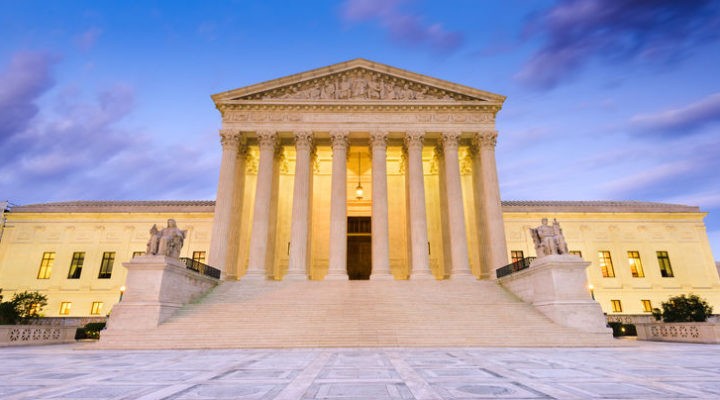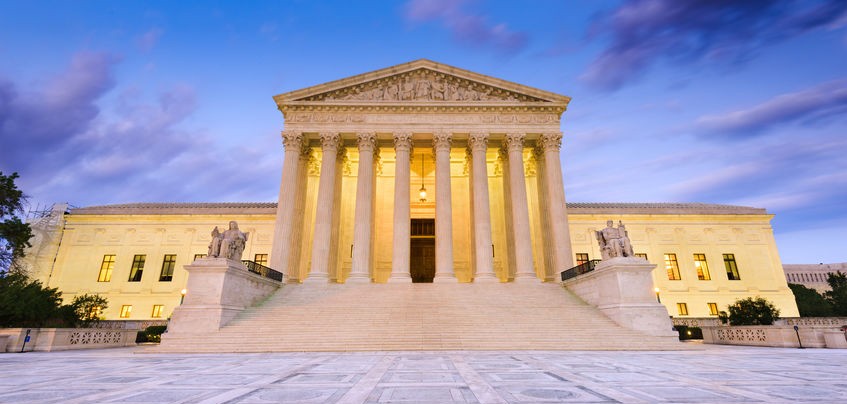For the second time in two months, the United States Supreme Court on Friday, April 9, issued a late-night, end-of-the-week ruling on a California church’s challenge to public health restrictions due to COVID-19.
But there’s something different about the latest ruling — the seventh time the high court has interacted with religion and coronavirus restrictions in the last 11 months: This time, the court’s majority appears to have tilted the scales in favor of religious practice against all other interests. At least that’s how critics see it.
“The ultra-conservative majority of the U.S. Supreme Court continues to redefine the constitutional promise of religious freedom for all as religious privilege for a select few,’ said Rachel Laser, president of Americans United for Separation of Church and State. “By once again undermining science-based public health orders meant to limit the spread of a deadly virus, the court is prioritizing the religious practices of a few over the health and safety of entire communities.”
The case
The case, Tandon v. Newsom, involved a request for a religious exemption to California’s public health order intended to reduce the spread of COVID-19. This order limited the size of in-home gatherings to no more than three combined households represented in any one meeting. The rule applied equally to all types of in-home gatherings, not just religious gatherings.
Jeremy Wong, associate pastor of Orchard Community Church, and home Bible study host Karen Busch of Santa Clara County, Calif., said the state’s restrictions prevented their normal weekly home Bible study and prayer sessions. They argued that “assembling for small-group, ‘house church’ fellowship is just as indispensable to their faith as attending Mass is for a Catholic.”
They argued that “assembling for small-group, ‘house church’ fellowship is just as indispensable to their faith as attending Mass is for a Catholic.”
Of the many court challenges to arise out of pandemic public health restrictions — including a large number in California — this is the first federal case to focus on in-home religious gatherings. Other cases have focused on in-person gatherings inside church buildings.
In an unsigned 5-4 opinion, the Supreme Court sided with the California pastors and against the public health advisories of the state. The court majority compared home Bible studies to hair salons, retail stores, personal care services, movie theaters, private suites at sporting events and concerts, and indoor restaurants. Current restrictions in California allow those venues to gather people from more than three households.
This discriminates against religious practice, the majority said.
A blistering dissent
However, Justice Elena Kagan — joined by Justices Stephen Breyer and Sonia Sotomayor — vehemently dissented from the majority, even declaring the majority continued to “disregard law and facts alike.”

Justice Elena Kagan
“The First Amendment requires that a state treat religious conduct as well as the state treats comparable secular conduct,” she wrote. Sometimes finding the right secular analogue may raise hard questions. But not today. California limits religious gatherings in homes to three households. If the state also limits all secular gatherings in homes to three households, it has complied with the First Amendment. And the state does exactly that: It has adopted a blanket restriction on at-home gatherings of all kinds, religious and secular alike.”
The court’s majority is wrong, she said, because the First Amendment does not require California to “treat at-home religious gatherings the same as hardware stores and hair salons — and thus unlike at-home secular gatherings, the obvious comparator here. … The law does not require that the state equally treat apples and watermelons.”
She added that even if that comparison were valid, the court majority has misunderstood or misrepresented the facts and science of the case.
Despite what the two California pastors claimed in their appeal, the lower court ruling on which the appeal was based did, in fact, conclude that activities like visiting stores or salons “pose a lesser risk of transmission” than at-home religious activities, Kagan wrote. She quoted three reasons affirmed by the lower court: (1) “When people gather in social settings, their interactions are likely to be longer than they would be in a commercial setting”; (2) “private houses are typically smaller and less ventilated than commercial establishments”; and (3) “social distancing and mask-wearing are less likely in private settings and enforcement is more difficult.”
“The law does not require that the state equally treat apples and watermelons.”
Chief Justice John Roberts did not join the majority but also did not sign on to Kagan’s dissent. His vote against the majority was not explained.
Those voting to favor the in-home Bible studies included the three Trump-era appointees to the court — Amy Coney Barrett, Neil Gorsuch and Brett Kavanaugh — along with Justices Clarence Thomas and Samuel Alito Jr. This is a case where Barrett’s replacement of Justice Ruth Bader Ginsburg swung a 5-4 majority from what one year ago would have most likely been an opposite outcome.
The ‘shadow docket’
The latest ruling is another in what legal scholars have dubbed the “shadow docket” of the Supreme Court. The term encompasses emergency orders and summary decisions that fall outside the court’s main docket of argued cases and decisions. Unlike more standard cases where oral arguments are presented and the court may take months to issue a decision, shadow docket cases do not typically involve oral arguments and, because they are declared as “emergency” cases, are processed rapidly.
COVID-19 has accelerated the trend toward such emergency rulings, which already was a growing trend under the Trump administration.
Shadow docket cases do not typically involve oral arguments and, because they are declared as “emergency” cases, are processed rapidly.
Reuters news service reported: “The Trump administration won shadow docket requests in 28 of 41 cases during his term — a near 70% success rate, according to Stephen Vladeck, a professor at the University of Texas at Austin School of Law. Just eight were filed in 16 years by the administrations of Presidents George W. Bush and Barack Obama, four of which were granted.”
Mark Joseph Stern, staff writer for Slate covering the courts, tweeted Saturday: “The Supreme Court uses an unsigned shadow docket opinion on Friday night to confirm that it has altered 3+ decades of precedent. This is not a plausible reading of Smith or Church of Lukumi. It’s a new rule — most-favored nation status for religion.”
Constitutional and religious liberty scholar Jim Oleske echoed that sentiment in a Saturday tweet: “In terms of significance, last night’s … opinion marks formal culmination of 31-year effort to undo Court’s decision in Emp. Div. v. Smith using ‘most favored nation’ theory proposed by one of Smith’s fiercest and most persistent critics.”
Related articles:
Supreme Court again overturns COVID restrictions on houses of worship
What does the Supreme Court’s midnight COVID ruling really mean for religious liberty?
As COVID cases soar, court’s retreat opens doors of churches
Noah had a quick trip compared to John MacArthur’s battle with Los Angeles County


